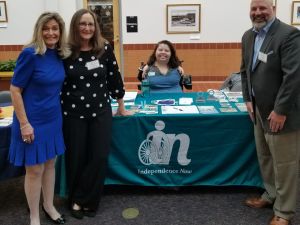Research in Practice- Data-Informed Decisions: Understanding Mathematical Thinking

Spotlight – Stories from the Field
Amy’s Challenge: How can I better understand student thinking while solving math problems and collect formative data virtually without having direct conversations with my students?
Amy Warren, Ed. D., Prince George’s County Public Schools
Amy, a special education resource teacher in a 6th grade co-taught general education math class, was having difficulties interpreting her students’ virtual math work in Peardeck and in Google docs. Her students were challenged by explaining their mathematical thinking virtually with drawings and representations. Prior to virtual learning when teaching in person, Amy found it easier for her students to verbally explain their thought process when solving problems rather than drawing a model or constructing math equations.
Amy used a form of Dynamic Assessment called “Flexible Interviews” to use following an assignment or assessment via FlipGrid and a Virtual Whiteboard for math regarding specific items she wanted to see modeling and reasoning for. She felt this would increase her understanding of student thinking, as well as potentially uncover any errors the students made while solving math problems. Her intention was for this to be an opportunity for “virtual probes” that would be student-directed, and would be completed independently. Amy designed weekly targeted math probes on FlipGrid for her students to complete. She then asked that each student reflect on his/her work by answering five questions. Question Development
Sample Student Instructions:
- Pick a math problem from this week: Why did you choose it?
- What was the problem asking you to do? Unlock the word problem prompt.
- Show me how you worked out the problem on the virtual whiteboard. Be a teacher to me.
- How did you decide what to do to solve the problem? Tell me how you knew what to do.
- Explain why your answer is a good answer to that problem using math language.
Teacher model of the problem solving process using FlipGrid
| “As students responded, I saw that some were mimicking the teaching style of the Khan Academy teachers that they had seen in class, which means that using those types of extra resources with others talking through problems as they worked them out was a good use of material to incorporate. One of our shyest students who used this type of structure during his FlipGrids recently wrote to me that this years’ experiences, including the FlipGrid work, have helped him know he “can answer more questions without worrying about getting it wrong.” Another student remarked that having the students step into the role of teachers using the FlipGrid was a “very good idea”, and the enthusiasm for using the medium resulted in more responses from this particular student. Some students tended to “overthink” how to explain things, giving extra ways to check their arithmetical answers, and others still did not understand how to follow each step in the instructions and to SHOW what was going on as they described it. Over time, the responses converged to what was truly being asked for. I was also able to pick up on nuances of what the students had not quite fully learned, taking back the nuggets of formative data to the classroom and revisiting them to clarify. One such important piece of information I gained was that the students were not 100% solid on the difference between “equal to” and “equivalent to”. Revisiting this because I listened to the words they used in the FlipGrids was a useful piece of information which in the virtual setting was immensely helpful (especially with students who were reluctant to verbalize or share their feedback during class).” – Dr. Warren,Teacher |
Implementation Plan
Time: Initially one hour to create questions and a model example on Flipgrid, additional time to post assignments and to teach students the process
Materials/Resources: A collaborative learning management system platform (Google Classroom, Schoology, Canvas, etc.), and video conferencing platform (Zoom, Google Meet, Skype, etc.), FlipGrid, student access to online whiteboard and/or worksheets they can annotate as they present
Steps:
Initial Set Up:
- Create the set of questions for students to respond to on FlipGrid.
- Create an example FlipGrid with a problem that is from students’ current assignment
- Model the use of the FlipGrid as a strategy to explain mathematical thinking
- Analyze student performance on the first attempt and modify the process if needed in accordance with IEP and SDI supports, e.g., break the process into smaller steps or decrease the number of questions asked
Regular Implementation:
- Choose the lesson that you want to have formative feedback on
- Create the FlipGrid and targeted questions that align with the lesson
- Assign the FlipGrid in the learning management system
- View students’ responses and use the information as formative data to plan for any needed remediation and targeted SDI
Implications for Practice/Conditions for Success
- Collaboration with general education co-teacher is critical for successful implementation
- Consider creating a predictable routine for the use of FlipGrid as a way to encourage participation of reluctant students
- Gradually add questions as students become more proficient with the process and technology
Supporting Research and Resources
Ginsberg, A. (2003) Test of Early Mathematics Ability – Third Edition (TEMA-3): Assessment Probes and Instructional Activities. Pro-Ed.
Ginsberg, H. (1997). Entering the Child’s Mind: The Clinical Interview in Psychological Research and Practice. Cambridge, UK: University Press.
Harvard Group Balanced Assessment in Mathematics Project. (1995) Assessing mathematical understanding and skills effectively: An interim report of the Harvard group balanced assessment in mathematics project. Cambridge, MA: Educational Technology Center, Harvard Graduate School of Education.
Koh, M.S. (2002). Organized probes used in tandem with a standardized instrument: Assessments probes and the TEMA-2. (Doctoral dissertation, Teachers College Columbia University). Dissertation Abstracts International.
Lids, C. S. & Elliott, J. G. (2000). Introduction. In C. S. Lidz and J.G. Elliott (Eds.) Advances in cognition and educational practice: Volume 6. Dynamic assessment: Prevailing models and applications, (pp. 3-11). New York: Elsevier Science.
Newhall. P. W. (2014). Executive function: Foundations for learning and teaching. In P. W. Newhall (Ed.), Language-based teaching series. Prides Crossing, MA: Landmark School Outreach Program.






